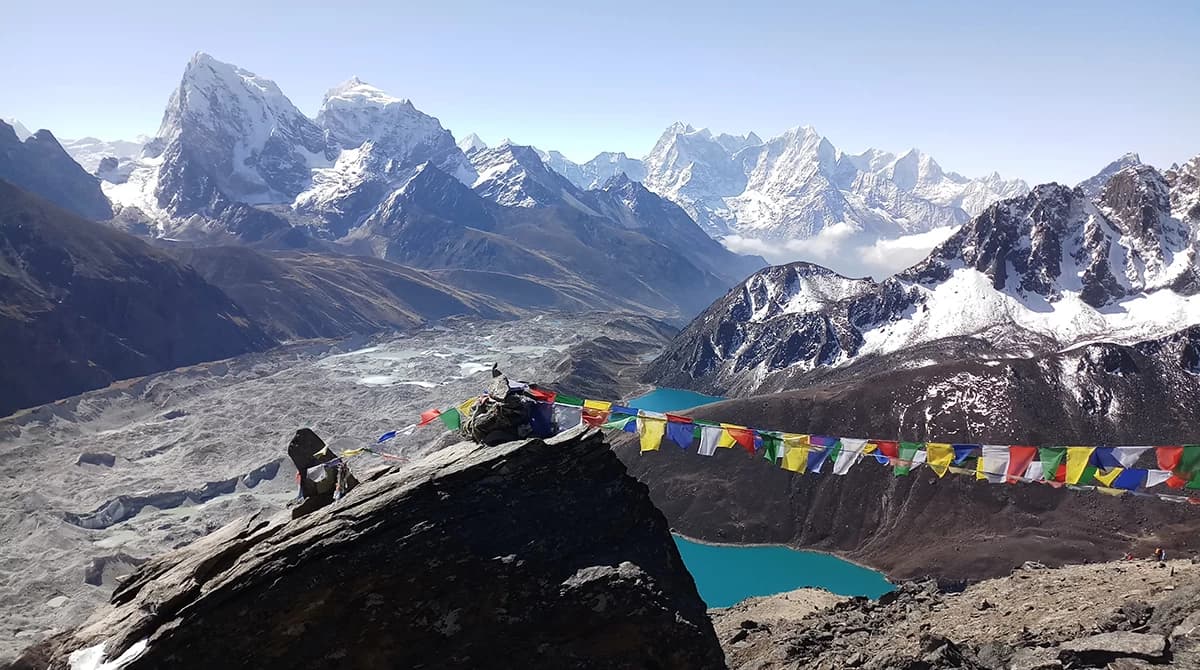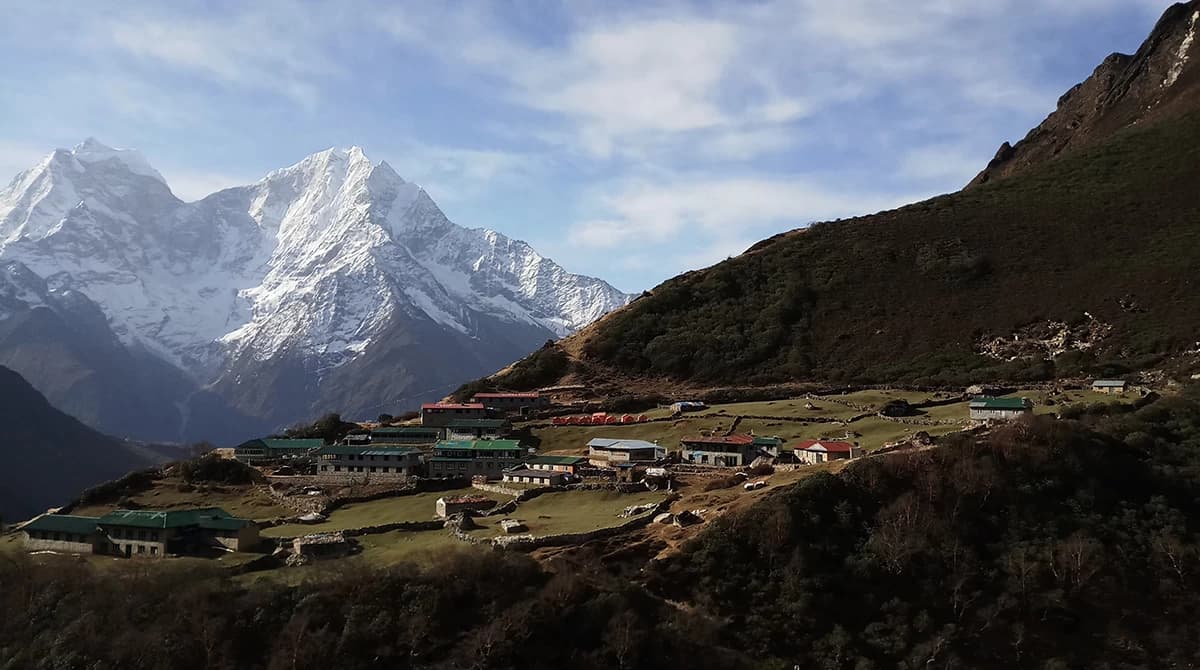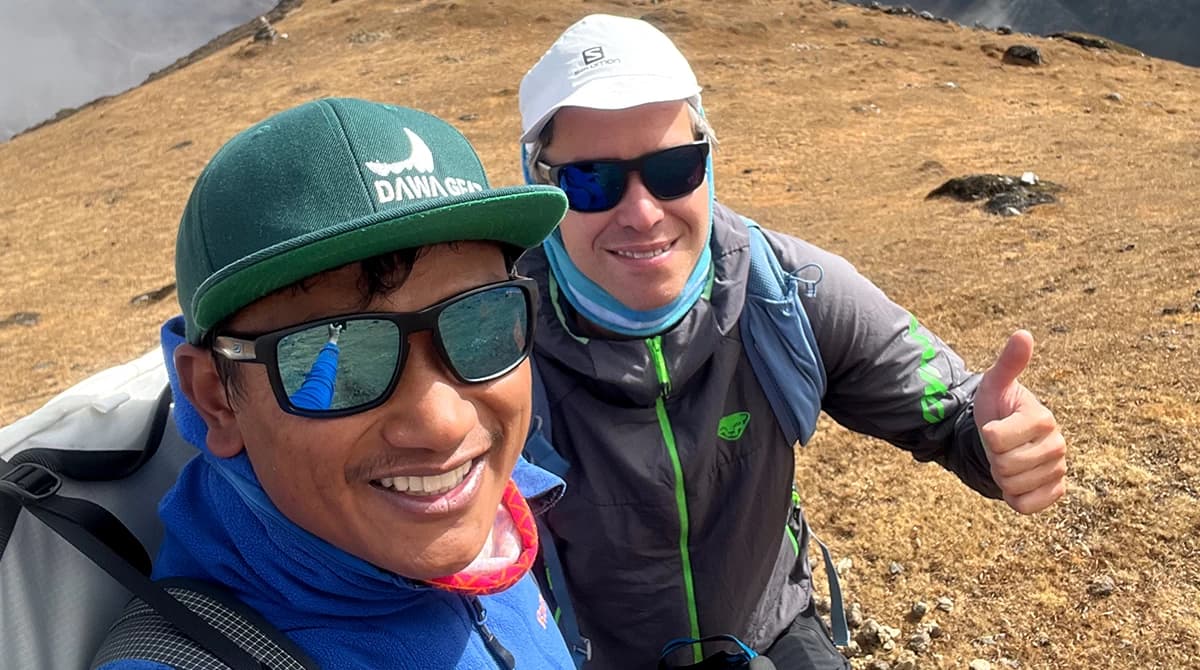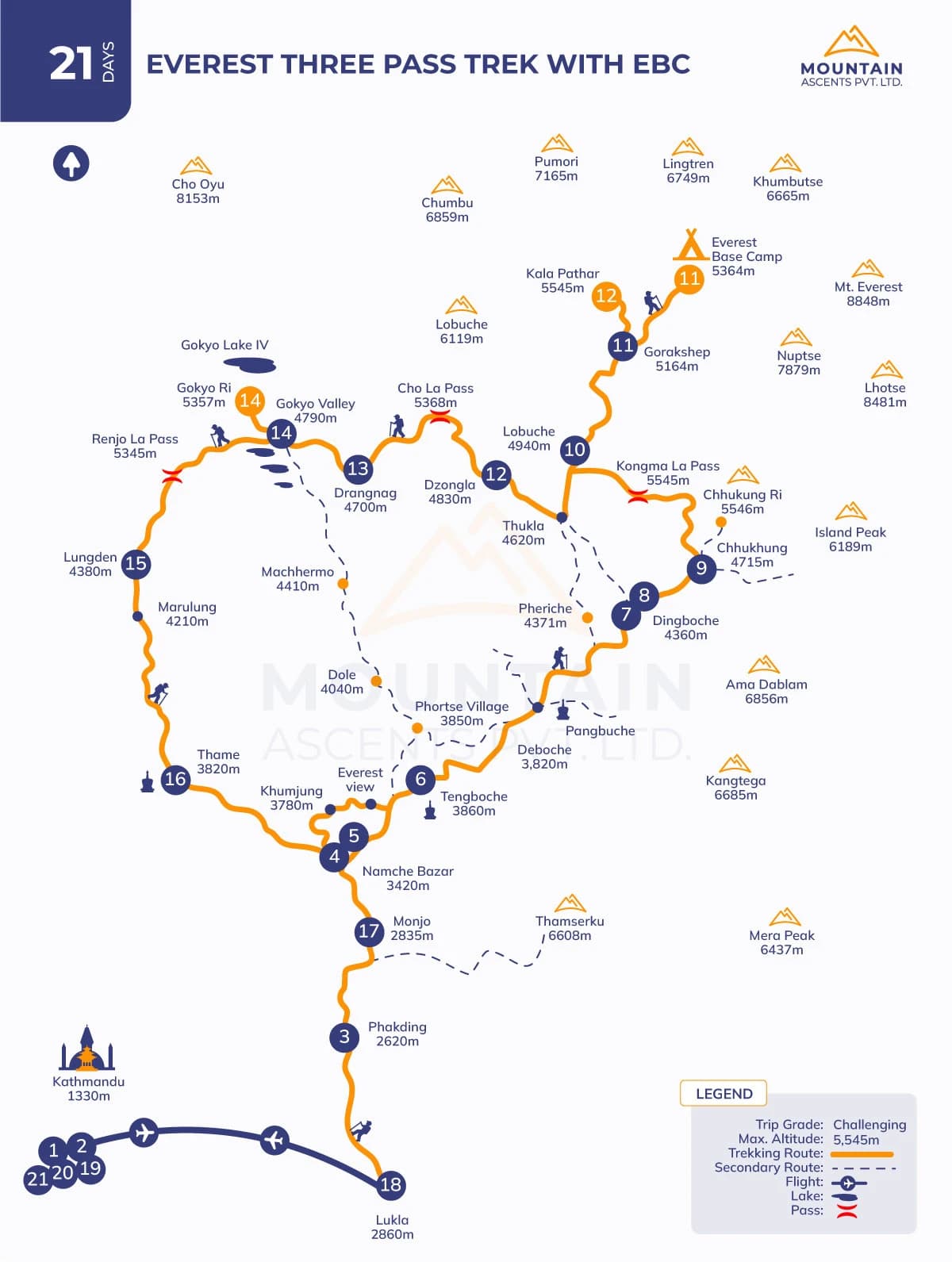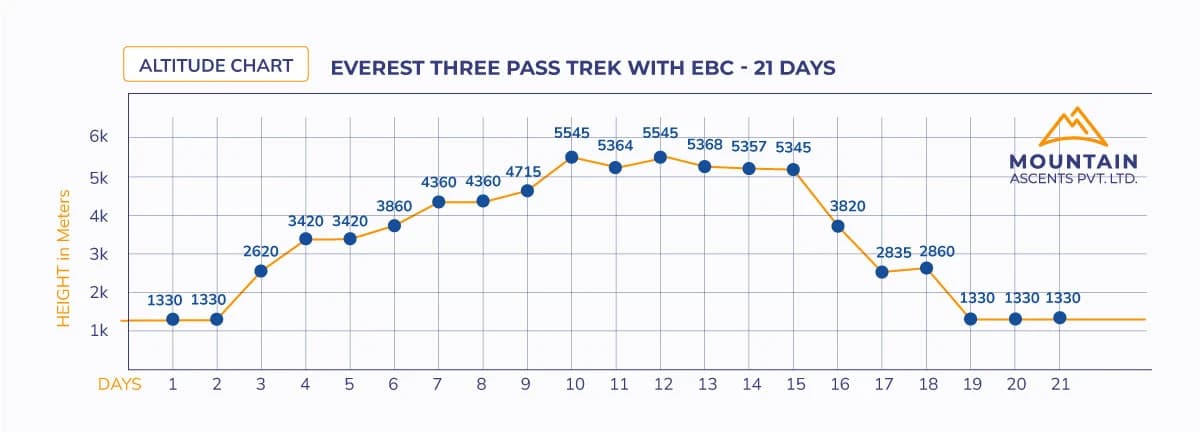The Everest Three Pass Trek with EBC is an unparalleled trekking journey that awaits you in the breathtaking Himalayas, offering mixes of the excitement of crossing high mountain passes with the breathtaking scenery of the Khumbu region, providing travelers with an unparalleled experience of both challenges and serenity. Trekkers are welcomed with incredible views of snow-capped peaks and beautiful valleys, beginning with an adventurous flight from Kathmandu to Lukla, the Everest region's entrance. The trek begins in Lukla and winds through scenic Sherpa villages, where the locals' rich culture and friendly hospitality offer an insight into mountain life. As the journey continues, trekkers are rewarded with panoramic views of some of the world's tallest peaks, including Everest, Lhotse, and Nuptse. Along the way, attractions like the renowned Tengboche Monastery in rhododendron forests provide periods of peace and spiritual reflection.
Surprisingly, the challenge of crossing three high mountain passes—Kongma La, Cho La, and Renjo La—truly differentiates this trip. Each pass offers various challenges and rewards, ranging from rugged terrain to breathtaking views of towering peaks. Throughout the walk, the Khumbu region's peacefulness surrounds trekkers, providing a sense of peace and closeness to nature. Whether standing in front of Everest's majestic peak or having dinner with local Sherpa families, every minute of this experience is filled with wonder and discovery. For those looking for the ultimate mountain ascent experience, the Everest Three Pass Trekking with EBC guarantees an incredible adventure through some of the world's most breathtaking scenery.
For a successful trip, trekkers must be well prepared for potential high-altitude concerns, including acute mountain sickness (AMS), generally also known as altitude sickness. Proper acclimatization, careful planning, and preparation are a must. Taking you deeper into the Khumbu Valley and its hidden gems, isolated from the comparatively crowded classic Everest Base Camp (EBC) Trek, in the remote Himalayas for a smoother experience, make sure you do not rush your steps, skip side hikes to high altitude, and include hardcore cardio exercises in your daily exercises. It is good to begin practicing high-altitude hiking in the high altitude for longer days a month before your departure date to the Everest Three Pass Trekking with Everest Base Camp (EBC).
To conclude, the Everest Three Pass Trek under the Sagarmatha National Park, home to the highest mountain in the world, Mt. Everest, and diverse flora and fauna, is a haven for trekkers, climbers, and nature lovers alike. It is a physically demanding endeavor, ideal for seasoned trekkers with high-altitude experience. Offering a perfect blend of challenging terrain, sweeping, changing, dramatic landscapes, cultural immersion, and spiritual rejuvenation, it is one of the most rewarding treks in the world to do with professionals of the field such as Mountain Ascents.
Trip Highlights
- A full exploration of the Kathmandu Valley before and after the electrifying Himalayan trip to the Everest/Khumbu region, boasting numerous culturally, religiously, and historically significant monuments, at least seven recognized as UNESCO World Heritage Sites.
- It is a scenic, rich flight to Lukla, an adventure that provides a unique perspective of the snow-capped mountain giants, traditional villages, and other natural wonders.
- Explore famous Sherpa towns and typical mountain dwellings such as Tengboche, Dingboche, Chhukung, and others, including the cultural and trade hub of the Everest Himalayas, and Namche Bazaar.
- Natural UNESCO World Heritage Site, the Sagarmatha National Park, its diverse flora and fauna, including rare Himalayan species of Himalayan Thar, Black Bear, red pandas, musk deer, snow leopards, and others.
- Side hike to scenic and high-altitude peaks like Kala Patthar, Gokyo Ri, and Chhukung Peak.
- Enthralling views of snow-capped mountain ranges like Everest, Cho Oyu, Ama Dablam, Nuptse, Lhotse, and others.
- Adventurous climb to the Everest Base Camp (EBC), Kong Ma La, Renjo La, and Cho La Pass.
- Heavenly sight of Khumbu Glaciers, Ngozumpa Glacier, Khumbu Icefall, and Gokyo Lakes.
- An insight into the simple, nature-connected Himalayan lifestyles of locals deeply rooted in Tibetan Buddhism and teachings, especially that of Sherpas.
- Encountering several religious monuments such as prayer wheels, mani walls, vibrant flags, Gompas, and monasteries, including Khumjung and Tengboche, etc.
What makes the Everest Three Pass Trek with Everest Base Camp (EBC) Special?
Often also referred to as the Three Passes Three Peaks Trek for making the way to three major Everest Himalayan passes—Kong Ma La (5,535m/18,159ft), Renjo La (5,388m/17,678ft), and Cho La (5,420m/17,782ft)—and three notable peaks—Kala Patthar (5,545m), Chhukung Ri (5,550m/18,208ft), and Gokyo Ri (5,357m/17,575ft)—the Everest Three Pass Trek with EBC is a thrilling adventure in Nepal’s Khumbu region, designed for trekkers and adventurers with extraordinary spirit for unparalleled challenge and rewards.
This Himalayan Odyssey stands out as one of the most thrilling and rewarding treks in the Everest/Khumbu region, offering high-altitude exploration, breathtaking scenery, cultural immersion, and a combination of adventure. Expect walking at a high altitude above 3,000 m for 5-7 hours each day. The journey includes making way through some steep ascents, descents, rugged terrain, snowy, and icy trails, more precisely around the Three High Pass, each offering unique views of peaks like Everest, Lhotse, Makalu, and Ama Dablam.
Trekkers also visit iconic landmarks of the Everest/Khumbu region at least once, must-see places like Everest Base Camp, Kala Patthar, and the serene freshwater Gokyo Lakes, including Sherpa villages, ancient monasteries, and spiritual hubs, all coming together to make it a once-in-a-lifetime experience.
Lukla, Namche Bazaar, and Tengboche Monastery
Marking the trek's starting and ending point for the journey to the Everest Himalayas, including for the Everest Three Pass Trekking with EBC, Lukla features a small yet iconic airport called Tenzing Hillary Airport, perched at 2,860 m. Surrounded by lush hills and the beautiful Dudh Koshi Valley, the mountain flight here is one of the most daring things to do.
Similarly, also called the official gateway to Mount Everest, the Namche Bazaar, at an altitude of 3,440 m, is a lively Sherpa town serving as the main trading hub of the Khumbu region. Nestled amidst the soaring hills, the vibrant town is one of the best acclimatization spots, featuring cozy lodges with modern amenities like wifi, ATM booths, cafes, and restaurants with Western delicacies.
Meanwhile, Tengboche Monastery, at an elevation of 3,867 m against the backdrop of the pyramid-like shaped Ama Dablam, is the spiritual heart of the region, perfect for practicing the mindfulness required for a long journey to reach the highly elevated Three Peaks. The serene monastery hosts daily Buddhist rites and rituals by monks, offering a moment of peace amidst the adventure.
Altogether these three landmarks provide you with an idea of the upcoming combined trek to the Everest Three High Pass with Everest Base Camp (EBC), an epic blend of adventure, challenge, culture, spirituality, and never-seen-before natural beauty.
Mesmerizing sunrises from iconic peaks like Kala Patthar, Chhukung Ri, and Gokyo Ri
Though these peaks lie at a distinctive distance from each other, sunrise from Kala Patthar, Chhukung, and Gokyo Ri is one of the most exciting parts of the Everest Three Pass Trekking with EBC. In proximity to Everest Base Camp (EBC) and the riverbed of Gorak Shep, Kala Patthar is the highest point of the trek in the Everest Himalayas, including the classic one. Situated at 5,545m, it acts as one of the best viewpoints to see Everest, especially during sunrise when trekkers are treated to an awe-inspiring view of Mount Everest and neighboring peaks like Nuptse, Pumori, and Lhotse.
At Chhukung Ri (5,550m), the sunrise revealed an unmatched magical panorama of Ama Dablam, Island Peak, and Lhotse, enhanced by the crisp morning air and sweeping views of the lush hills, a paradise for photographers and adventurers alike. This peak is among of the lesser-visited viewpoints, offering a true sense of adventure in solitude without any compromise to the views of snow-clad summits. Meanwhile, nearby Gokyo Lake is Gokyo Ri at 5,357 m above sea level, presenting you with enchanting, 360-degree views of Everest, Cho Oyu, and Makalu, along with the shimmering turquoise beauty of Gokyo Lakes. The scenery is epic to witness during sunrise when the light plays amazingly across the glaciers and peaks, creating unforgettable highlights that captivate the hearts of all who see it.
Traversing the Three High Passes
Connecting the Himalayan village of Chhukung of Imja Valley with Lobuche village near the Khumbu glacier, Kong Ma La links the Everest Base Camp Trail with Gokyo Lake, Cho La, and Renjo La, joining the Gokyo Lake area to the Nagpala Valley, which is the pinnacle of adventure on the Everest Three Passes Trek. Each pass presents its own set of challenges and rewards that can be both physically and mentally challenging even for seasoned trekkers, climbers, and mountaineers.
Kongma La Pass, at an altitude of 5,535 m above sea level, is the first and the highest Everest mountain pass in the remote area, offering sensational mountain vistas of Makalu and Nuptse specifically. Trekkers are required to navigate steep ascents, glacial moraines, and rugged terrain, putting a testament to basic mountaineering skills, physical endurance, and fortitude. Remarked for its icy pathways and rocky terrain, giving you access to the blue gem of the Everest region, the alpine glacial lakes of Gokyo Valley and tranquil Gokyo Villages, Cho La Pass at an altitude of 5,420 m adds an adventurous element beyond the typical trekking routes with close-up views of Cho Oyu and the turquoise beauty of the lakes.
Last but not least, the Renjo La Pass, 5,360 m above sea level, is the less-trodden trail rewarding you with the unspoiled and expansive views of Everest, Lhotse, and other surrounding peaks, including the typical mountain villages of Dzongla to the east and the village of Thagnak to the west. It takes a lot of effort to embark on these high passes worth a shot, providing you with a deeply gratifying sense of achievement and experiencing the untouched and unexplored beauty miles away from chaotic urbanization and stuffed trekking trails. Therefore, Everest Three Pass Trekking with EBC is the ultimate adventure in the Everest Himalayas that guarantees an unparalleled authentic experience, unveiling unique beauty in each step you take.
An authentic Sherpa culture and hospitality
Showering you with the untamed and outstanding beauty of the popular Everest Base Camp Trekking Trail with the off-the-beaten route of Three High Passes of the Everest Himalayas in Nepal, this Everest Three Pass Trek with EBC promises you an unmatched look into the lives of the locals, the Sherpa. Renowned in the world for their superhuman-like mountaineering skills, resilience in high altitudes, and friendly nature, this Himalayan community possesses a distinctive way of life, customs, culture, festivals, and dialects.
Often also referred to as the high-altitude beasts, the “Tigers of snow,” Sherpas' way of living showcases strong cultural ties to Tibetan Buddhism. Right from the trek starting point, Lukla, trekkers would be able to witness their day-to-day activities, and if your time of visit coincides with local festivals such as “Mani Ridum” and “Dumji,” you may even get to be part of the enriching cultural experience. As you make your way through the villages like Namche Bazaar, Thame, Lukla, Tengboche, Dingboche, Lobuche, and others, primarily inhabited by Sherpas, trekkers will get to encounter warm, genuine hospitality, ancient monasteries, and unique traditions of the Khumbu region of Nepal.
One of the major spiritual, cultural, and religious highlights is the Tengboche Monastery, which offers insight into the deeply rooted Buddhist culture intertwined with the natural grandeur, physical challenges, and cultural immersion making the Everest Three Pass Trek with EBC a once-in-a-lifetime experience.
Pristine Natural Beauty of Everest Base Camp and Gokyo Lake
Located at a high altitude, the Everest Base Camp (EBC) is an incredible viewpoint to grasp the picturesque and pristine natural beauty of the Everest Trekking Region, the Sagarmatha National Park, and the surrounding Himalayas, including the freshwater alpine Gokyo Lakes. Though you might not be able to see the top of Mount Everest, the highest point on the earth, the sense of serenity as you witness the grandeur of the Khumbu Icefall and towering peaks like Everest, Nuptse, Lhotse, and others is immeasurable.
Similar is the Gokyo Lake, the group of six alpine glacial lakes ranging in altitude from 4,700–5,000 m (15,400–16,400 ft) that unveils a serene paradise shimmering turquoise in contrast to snow-covered peaks, including Cho Oyu (8,188 m). These two destinations, hence, are perfect for unwinding and taking in the tranquil landscape that you will get to explore at the fullest during the Everest Three Pass Trek with Everest Base Camp (EBC), making it an unforgettable journey.
The Everest Three Pass Trek with EBC's 21 Days itinerary and route
Your 21-day Everest Three Pass Trek with EBC begins with your landing at Tribhuvan International Airport (TIA) in Kathmandu, Nepal. However, you will begin walking in the Everest Trekking Region only on the third day after a short yet scenic flight from Kathmandu to Lukla that is directed from Manthali, Ramechap during the peak trekking seasons of spring and autumn. The flight is breathtaking, and so is the trek that goes through the villages of Phakding, Namche Bazaar, Tengboche, Dingboche, Chuukung, and Lobuche, and finally to the Everest Base Camp (EBC) and iconic Kala Patthar.
According to this Everest Three Pass Trekking with EBC itinerary of 21 days, by the time you have made it to Everest Base Camp, you will have already conquered one of the high passes, Kong Ma La, after a one-day acclimatization in Namche Bazaar and Dingboche, so you do not have to encounter symptoms of acute mountain sickness (AMS). Once you arrive at the Kala Patthar based on this route, your next target is the Cho La Pass to reach the hidden treasure trove of the Gokyo Valleys, Lakes, and Peak that initiates through the traditional villages of Dzongla and Dragnag.
After you spend adequate time in Gokyo, hike to Gokyo Ri for acclimatization, rewarding you with magnificent mountains and surrounding vista. You will go to Lungden from Gokyo Village and finally reach the last of the Everest Three Pass Trek, a high mountain pass called Renjo La, blessed with the majestic views of the Gokyo Lake system and gigantic Himalayan peaks like Everest, Lhotse, Makalu, Cho Oyu, Ama Dablam, and others. Once you make it to Renjo La, you will descend gradually to Thame, Monjo, and finally to Lukla to catch a flight back to Kathmandu, marking the end of the trek to the Everest Trekking region, whose aim is to conquer the Three Pass and Everest Base Camp.
Though you can customize the itinerary as per your needs and preferences, adding some extra days or even deducting trekking days with the direct helicopter to Kala Patthar and others, this 21-day itinerary is considered the best route for its balanced physical demands, ample time for acclimatization, and full exploration of the major highlights of the Everest region, taking you deeper. Mountain Ascents crafted this route meticulously, ensuring a safe and sound adventure offering a perfect mixture of adventure and cultural exploration while prioritizing your health and safety in the high-altitude environment.
21-Day Everest Three Pass Trek with EBC Cost for 2025 and 2026
Depending upon the group size of trekkers, the Everest Three Pass Trekking with EBC Cost cost for 2025 and 2026 can range from approximately USD 1,500 to USD 2,500 per person or more and may vary from trekking operators to operators and the level of service you have chosen for yourself. At Mountain Ascents we are offering a special discounted budget for groups of trekkers of more than 10. Contact us now for the best package price that covers expenses for essential trekking items and needs such as accommodation in tea houses, meals, mandatory permits, domestic flights, and guided services.
Please note that any change in lodging, services, food, and side trips can influence the Everest Three Pass trekking with Everest Base Camp (EBC) cost, including a deluxe room in Namche, which can go up to USD 150 per night.
